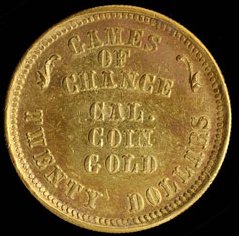
PREV ARTICLE
NEXT ARTICLE
FULL ISSUE
PREV FULL ISSUE
ON THE DIANA GAMES OF CHANCE TWENTY DOLLAR GOLD PIECE
Last week Harvey Stack submitted a great essay on the value of books for numismatic research. As noted last week though, there are differing opinions on the genuineness of the coin he used as an example, the Lilly Collection example of the "Diana Games of Chance" twenty dollar gold coin. Emails were sent flying this week among E-Sylum readers and various experts on private gold coinage. Here are some selected opinions from both camps.
-Editor


Harvey Stack writes: The reason I described as I did, was that in usage and truth the private assayers in California, made coins as a MONETARY NECESSITY. So when you are running a wild and gigantic Gambling Operation, you needed things like "chips" to facilitate PLAY. So I guess it should be considered a MONETARY PROVISIONAL $20.00 GOLD. David Gladfelter writes: I'm not so sure that the “Diana” is a modern fantasy. How could it be? If it took Harvey Stack and his team of researchers so much effort to find a contemporaneous reference to this token, with a factual description that is a perfect match to the token, how would a fantasy artist acquire the knowledge to manufacture such a piece? Of course that is the risk – that a faker will educate himself before making up a piece, so as to give it the appearance of being historical. But if the “Diana” is of the fabric, style and workmanship of the period, it is probably genuine, don't you think. Duane Feisel forwarded me a lengthy discussion thread on the topic. Here are some highlights:
Karl Moulton writes: I enjoyed reading what Harvey Stack had to say about the value of books, and I completely agree with him. However, there were a few things that were not correct in his recollections regarding the $20 gold Diana coin. As outlined in Helper's book, there was no house gambling, like there is today. There would have been no need for the Diana, or any other establishment to create any gaming coins (or "chips" as Mr. Stack and Mr. Ford wish to call them). I believe there are no other such pieces known, especially in gold, from the hundreds, if not thousands of gambling halls that were operating throughout California during the 1850's. According to my copy of Helper's "The Land of Gold, Reality Versus Fiction" book, pgs. 70-74, the gambling floor was comprised of nothing but rented tables with different "proprietors" at each one; and each table had it's own "bank" that the "proprietors" of the tables controlled. "The bank", according to Helper, p.72, "is composed of gold and silver coin; it must be one or the other, or both of these metals in some shape - whether in dust, ingots, bullion, or coin; for these constitute the sole recognized currency of the State, there being no paper or bank-notes in circulation". Notice that Helper never described any "chips", "tokens", or house money. In spite of what Mr. Stack suggests, Helper's book does not validate or "confirm" that the $20 gold Diana coin that exists today was struck in the 19th century or ever used at the Diana gaming establishment. John Ford related that there were two such Diana pieces in Dave Bowers' 2002 book titled "A California Gold Rush History", footnote, p.350. If anyone knows the whereabouts of a second example, I for one would like to know where it is (or was, as it might have been melted), as I'm trying to finish up a few loose ends in my forthcoming book titled, "John Ford and the Franklin Hoard". One other minor point of contention is the 1955 citation of the Diana having been sent to Stack's from an unnamed sender. According to an invoice in my possession, (acquired from the 2005 Ford Library part II sale, lot 1090) Ford traded the $80.40 Justh & Hunter gold bar and the $20 Diana gold coin to Stack's together on September 19, 1958. Confirmation of this can be read in the lot description. Stack's sold both of these, and many other previously unknown pieces that Ford and Stack's had authenticated, to Mr. Lilly for an undisclosed amount. Both of those pieces have been suspect for a long time, with the $80.40 Justh & Hunter bar being declared a fake in 2003 by Evans, Holabird, and Fitch in their 3 part article that appeared in the Brasher Bulletin titled, "The Good, The Bad, and The Ugly". The "fatal flaw" was a round, noticeably double punched, Internal Revenue stamp (1864-1869) on a gold bar dated 1857. Additionally, the logo did not match the genuine Justh & Hunter gold bars that had been recovered from the S.S. Central America shipwreck. The description of the Diana $20 gold coin in the NNC collection is most likely accurate, in that it is a mid-twentieth century "fantasy" coin and part of the "Franklin Hoard" material, like the $80.40 Justh & Hunter gold bar. Yes, there is much value in books, as well as all other printed references, when doing research on American numismatics and other subjects.
To read the earlier E-Sylum article, see:
HARVEY STACK ON THE VALUE OF BOOKS
(www.coinbooks.org/esylum_v13n23a09.html)
The Numismatic Bibliomania Society is a non-profit organization promoting numismatic literature. See our web site at coinbooks.org. To submit items for publication in The E-Sylum, write to the Editor at this address: whomren@gmail.com To subscribe go to: https://my.binhost.com/lists/listinfo/esylum All Rights Reserved. NBS Home Page Contact the NBS webmaster 
|